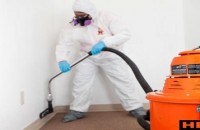What Should You Do About Mold in Your Home?
 If I asked the average person what they knew about household mold, I suspect their first thoughts would go to moldy food and then maybe to the idea that mold growing in your home is bad. That is true, of course, but that shouldn’t be where your knowledge of mold ends. It’s a good idea to be informed about the types of mold, how dangerous they are, and what to do if you find it in your home. Armed with that knowledge, you can keep yourself and your family safe from breathing in potentially dangerous toxins due to mold growth.
If I asked the average person what they knew about household mold, I suspect their first thoughts would go to moldy food and then maybe to the idea that mold growing in your home is bad. That is true, of course, but that shouldn’t be where your knowledge of mold ends. It’s a good idea to be informed about the types of mold, how dangerous they are, and what to do if you find it in your home. Armed with that knowledge, you can keep yourself and your family safe from breathing in potentially dangerous toxins due to mold growth.
Here are a few basic facts about mold that I believe will help you stay safe and healthy in your own home.
Types of Household Mold
Not all molds are the same. The most common types found in homes are Cladosporium, Penicillium, and Aspergillus. Cladosporium is most commonly found outside, but it can also grow in damp environments like toilets and bathtubs. It can cause severe allergic or asthmatic reactions.
Aspergillus is a very common mold but a very dangerous one. It’s most common to find in flooded basements and it produces aflatoxin, which is extremely toxic and can cause major health problems.
Penicillium is the mold we know that grows on food. It carries airborne spores that can cause unpleasant allergic reactions, and, of course, eating it when it’s on food is very unpleasant for the digestive system.
The Health Risks of Mold
While not all mold causes the same level of health concerns, they can all cause problems. Someone with respiratory issues like asthma or allergies has the most cause for concern, as even molds generally considered non-toxic can aggravate their breathing conditions. Even for people without those conditions, however, mold exposure can cause breathing problems and, in extreme cases, mycotoxin toxicity, which can cause serious, life-threatening illnesses.
The Most Dangerous Type of Mold
The term “toxic mold” is used to describe the most dangerous molds. These molds all produce mycotoxins, which can be extremely harmful when exposed to them on a daily basis. The mold Stachybotrys chartarum is considered one of the most dangerous due to the high levels of mycotoxins it contains. Fortunately, it is also one of the less common molds, found mostly in homes that contain gypsum board as part of their building materials.
What To Do About Mold
Some mold is easy to clean up yourself with very few health concerns. You don’t need to call someone in just to scrub out your shower. In general, if the moldy area covers less than 10 square feet, you can clean it up with bleach and water. Open the window to make sure the room is well ventilated and wear gloves, goggles, and long sleeves to limit your exposure to the mold.
If there is more than just a small patch of mold, however, or if you smell it but can’t locate it, you’ll want to call in a mold remediation professional as soon as possible. Do a little research on the cleanup company well to make sure you’re getting someone who knows how to do the job right. You should also keep in mind that if mold is growing on items like a flooded carpet or old clothes in the attic, you will need to throw those items away. Mold growth is often found in the aftermath of a flood or other water damage scenario, so be extra cautious. Don’t risk your health!



